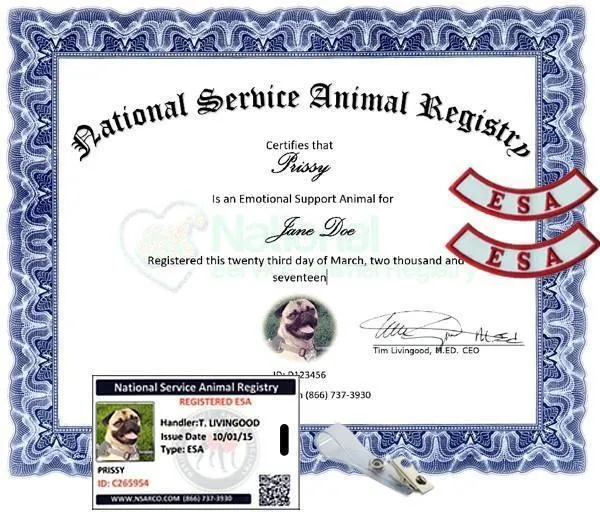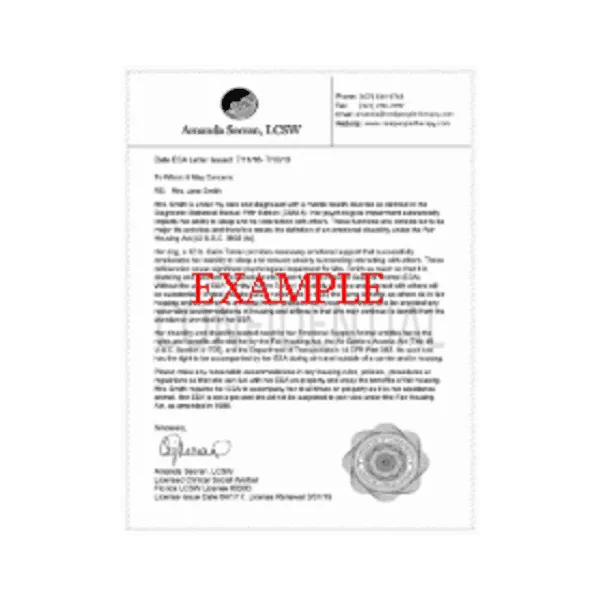Everything You Need to Know About ESA Letters for Air Travel
If you’re searching for information on “esa letter for airlines,” chances are you have an emotional support animal (ESA) and want to know the rules for flying with your furry companion. In this article, I’ll cover the basics of ESA documentation and airline policies so you have no worries about traveling with your emotional support critter.
What is an ESA Letter?
An ESA letter, sometimes called a prescription letter, is a document written by a licensed mental health professional (like a therapist or psychologist) stating that you have a disability as defined by the Fair Housing Act or Air Carrier Access Act and your ESA provides emotional support that alleviates one or more symptoms of that disability. This letter allows you to have your ESA with you in no-pet housing and bring them aboard flights in the cabin with you at no extra cost.
Do I Actually Need an ESA Letter?
Yes, you do need a valid ESA letter in order to bring your emotional support animal with you in housing and on aircrafts. Airlines will deny boarding to an animal without documentation from a mental health professional. From my experience working in therapy, I’ve had numerous clients who tried bringing untrained pets onboard as “support animals” and faced refusal or fines as a result.
The letter needs to clearly state that you have a diagnosed mental health condition, not just general anxiety or depression, for which you require the specific animal as treatment. It also must name both you and your ESA. Incomplete or invalid letters will not be accepted by landlords or airlines.
How Do I Get an ESA Letter?
To obtain an ESA letter, you’ll need an established relationship with a mental health provider who can properly evaluate your need for an emotional support animal. Many online sites peddle fake ESA letters, so make sure to see a licensed in-person professional to receive a legally valid one. I’ve seen clients waste money on sham certificates only to be denied boarding.
During an appointment, your provider will discuss your condition, determine if an ESA would aid your treatment, and if so will draft the letter on their professional letterhead. The entire process, including evaluation, diagnosis and letter, typically needs to be completed in-person to be considered legitimate. Telehealth appointments alone will not suffice according to air carrier guidelines.
How Long is an ESA Letter Valid?
Most airlines and housing providers will accept an ESA letter as current and valid for up to one year from the date issued by the mental health professional. However, some may ask to see documentation that’s no more than six months old. When your letter nears expiration, simply schedule a follow-up appointment with your provider to have it renewed if you still require ESA accommodation.

What Information Should an ESA Letter Include?
- Name, title, license/certification credentials and contact information for the mental health professional who issued it
- Patient’s name
- Description of patient’s disability/diagnosis and how it substantially limits one or more major life activities
- Statement that the ESA provides emotional support or treatment benefit to patient
- Date the letter was issued (should be within 1 year of intended travel date)
Airlines like the major ones basically think a valid letter hits all these major points clearly indicating your need for an ESA versus just a pet. If anything looks questionable, they may deny animal entry.
Airline ESA Policies
While federal law requires airlines to allow registered emotional support animals to fly with their owners in-cabin and at no extra cost, each carrier sets its own specific rules regarding ESAs that passengers must follow.
Most notably, Delta, American, United, and Alaska all prohibit certain breeds of dogs in the cabin even if alleged service or assistance animals. Some foreign carriers also ban ESAs altogether due to public health policies.
ESA owners also need to check airline policies on advance notification timeframes, paperwork submission deadlines, fare class requirements, crate vs. harness rules, and more. Oversights could end up stranding you and your critter friend at the airport.
It’s always wise to obtain ESA documentation a few months before travel and contact the airline directly to ensure you and Fluffy clear everything needed for takeoff and landing.
My Experience with ESA Air Travel
Despite having a legitimate diagnosis and current ESA prescription, I still ran into hassles flying with my dog as an “emotional support peacock,” as some might joke. Even with all paperwork in order, I got extra screening from TSA for Buddy’s crate and interrogated at the gate by a doubtful agent.
My advice? Show up extra early and be polite yet persistent about your rights if challenged. Bring any prescribed gear like a carrier or leash as well as two copies of the ESA letter – one for the ticket counter and one at security. With patience and a calm attitude, we finally made it onboard together without incident.

It’s not a perfect system, but advocating educatedly for your furry family member’s needs can help make that plane ride a whole lot less stressful, at least for both of you!
Common ESA Misconceptions
Perhaps the biggest mix-up many have around ESAs is thinking they enjoy the same public access rights as trained service dogs. That’s absolutely not the case.
Emotional support animals are only legally protected under the FHAA and ACAA for housing and air travel accommodations based on a person’s disability-related need. They do not have public access to places like restaurants, stores, medical facilities, etc. where pets are prohibited.
An ESA is also not limited to just dogs – any domesticated animal can potentially be an emotional support critter. However, airlines may limit species allowed in cabin due to safety factors like size.
While ESAs do provide important therapy benefits, proper training and behavior control is a considerate courtesy when taking hairy helpers into high-traffic areas. That generally makes these outings smoother for all involved species!
Final Thoughts
Anyone using an emotional support animal to help manage an ongoing mental or emotional condition should thoroughly research accommodation policies and requirements. With diligent preparation, a valid ESA letter, some patience at security screening, and understanding of correct public access privileges, you and your pet pal can hit the skies together with minimum turbulence.
Whether you have your own experiences flying with Fifi or just found this overview helpful, I hope it answered your questions about ESA letters and airline travel. Feel free to ask if any part needs more clarification. Wishing you many happy travels ahead in good emotional and furry company!

Essential Information for Choosing an Airline
| Airline | Route Options | Baggage Allowance | Seat Comfort | On-time Performance |
|---|---|---|---|---|
| Delta | Extensive domestic and international routes | First checked bag free, second bag $60 | Varied comfort depending on class of service | Typically 75-80% on-time |
| American | Large domestic and international network | First checked bag free, second bag $60 | Varied comfort depending on class of service | Typically 75-80% on-time |
| Southwest | Primarily domestic routes without international flights | Two checked bags fly free | Standard coach seats | Typically 75-80% on-time |
| JetBlue | Primarily domestic routes adding more international options | First checked bag free, second bag $60 | Varied comfort depending on class of service | Typically 80-85% on-time |
| Alaska | Primarily West Coast routes with expanding options | First checked bag free, second bag $60 | Varied comfort depending on class of service | Typically 80-85% on-time |
FAQ
-
Can I bring my emotional support animal on the plane with me?
Generally, yes you are able to bring your emotional support animal on the plane as long as you have documentation from your doctor or mental health professional. Most major airlines require this letter to be less than one year old. Some airlines may impose additional requirements too.
-
What type of animal can be an emotional support animal?
While dogs are most common, cats and even smaller animals like rabbits can be considered emotional support animals. Normally, the animal has to be domesticated and not be a unusual or exotic pet. The animal should also be trained well to behave properly.
-
Do I need special paperwork for an emotional support animal?
Yes, you basically need a note from a licensed mental health professional like a therapist or doctor stating that you need the animal for emotional support due to your mental health condition. This is commonly called an emotional support animal letter or ESA letter. It varies but it should mention your diagnosis and that the pet helps alleviate your symptoms.
-
“Can the airline deny me from boarding with an ESA?”
Possibly, if the animal is acting disturbed or perhaps the letter seems fake. Normally, they have to let you fly with an ESA as long as it remains well behaved. On the other hand, certain small aircraft may turn down ESAs due to space limits. Nevertheless, major airlines should not reject a legitimate ESA unless there is a kind of safety reason.
-
Do I need to pay fees for an emotional support animal on a flight?
No, an ESA is not considered a pet so you won’t be charged pet fees. However, the animal has to remain at your feet under the seat during the whole flight. It can’t occupy another passenger’s seat like a regular ticketed pet would. Additionally, you are responsible if the animal causes any disruptions or damages.
-
Is an ESA letter valid for more than one airline?
Yes, an ESA letter is not airline-specific. As long as it meets the airlines’ criteria of being current (usually less than a year old), an ESA letter allows you to travel with the animal on any airline. The letter basically certifies your need for the animal generally rather than only on one particular flight.
-
“I’m curious, how can I get an ESA letter?”
To obtain an ESA letter, you need to see a licensed mental health professional like a therapist, psychologist or psychiatrist. During an appointment discuss how your disability or medical issue affects your life and why you think an emotional support animal would help alleviate your symptoms. If the provider agrees, they’ll provide documentation stating you need the animal for emotional support. Make sure the letter covers all required details required by airlines.

